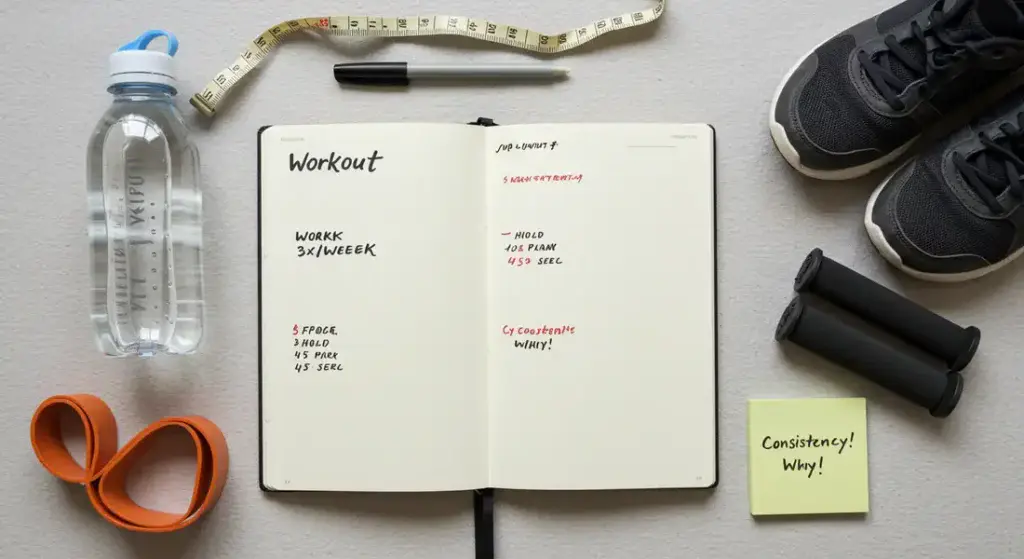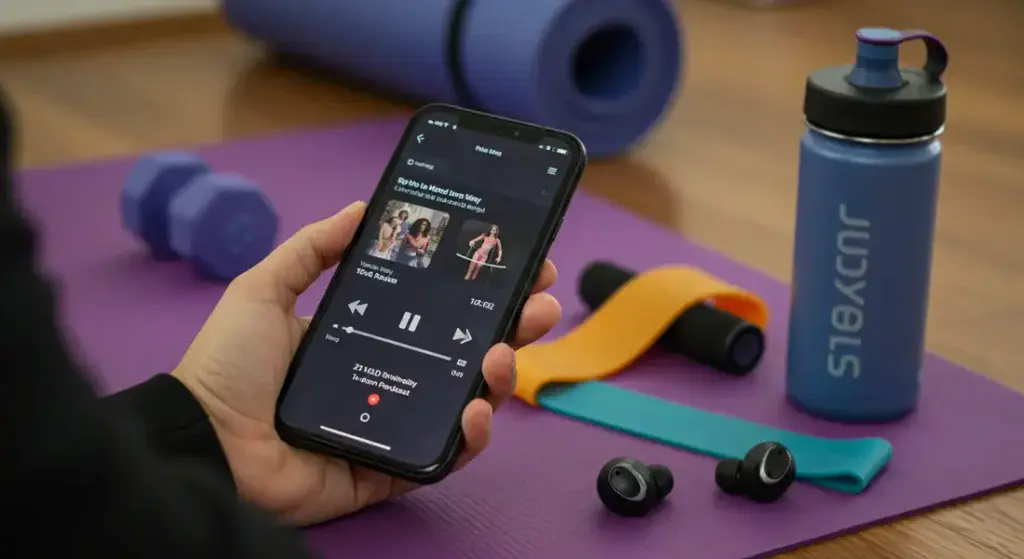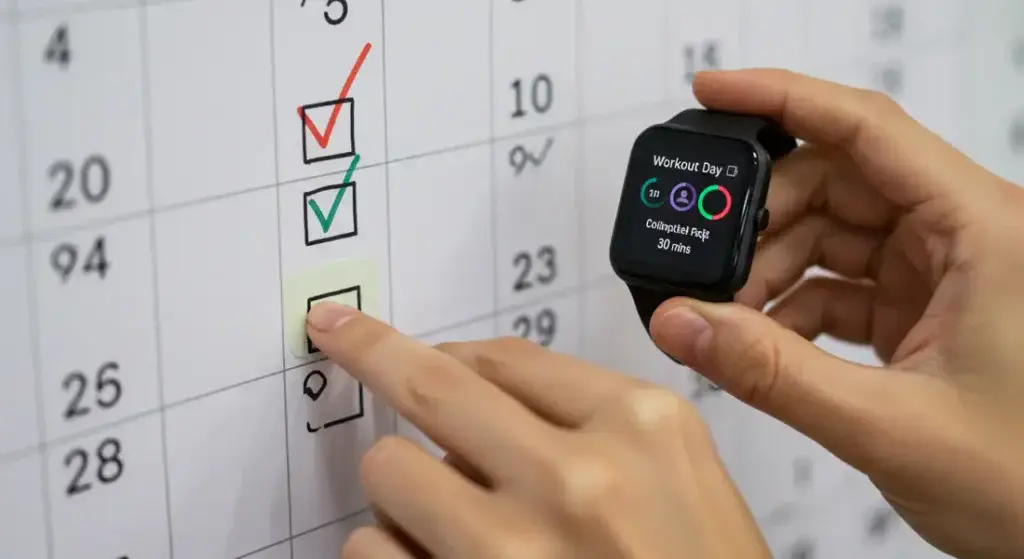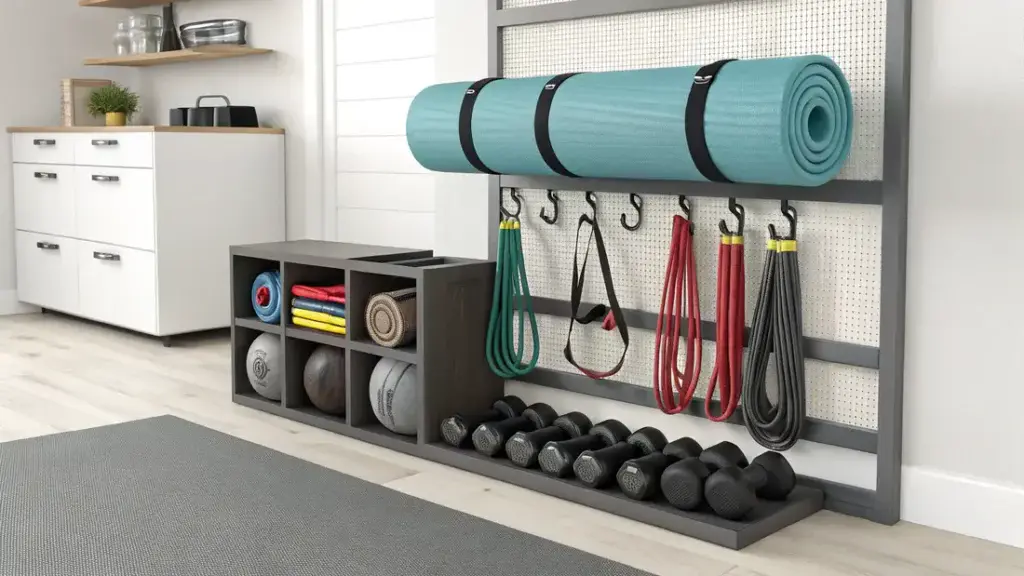You’ve made the decision to embrace home fitness – that’s fantastic! You’ve maybe even set some goals and planned a schedule.
But then… reality hits. The sofa looks incredibly comfortable, chores suddenly seem urgent, and the idea of pushing yourself through a workout with no one else around feels… well, hard.

If this sounds familiar, you’re not alone. Staying motivated when exercising solo is one of the biggest hurdles beginners face.
Unlike a gym with its bustling atmosphere, scheduled classes, and potential for social interaction, home workouts require a different kind of self-discipline.
But the good news is that motivation isn’t some magical quality you either have or don’t – it’s a skill you can build and strategies you can implement.
This guide provides practical, actionable tips specifically designed to help you stay consistent and engaged with your home fitness routine.
As a vital part of our Beginners Guide to Starting Home Fitness – Your First Steps, mastering motivation ensures your well-laid plans – like your Creating a Beginner-Friendly Workout Schedule and your carefully considered Setting Realistic Fitness Goals for Beginners – actually lead to long-term success.
Let’s learn how to keep that fire lit!
Why is Solo Motivation Sometimes Harder?
Understanding the challenge helps address it:
- Lack of External Accountability: No trainer waiting, no workout buddy relying on you.
- Comfort Zone: Home is designed for relaxation; switching to exertion mode takes conscious effort.
- Distractions Abound: Laundry, emails, family, pets – the potential interruptions are endless.
- No Social Buzz: You miss the energy and subtle peer pressure of a group environment.
- Immediate Feedback Loop is Missing: No instructor correcting form or offering instant encouragement.
Recognizing these factors isn’t an excuse, but it validates the feeling and allows us to target solutions.
Tap Into Your “Why” – The Foundation of Motivation

This is the single most important strategy. Why did you start this in the first place?
- Revisit Your Goals: Remember those SMART goals you set (or should set now! See our Setting Realistic Fitness Goals for Beginners guide? Keep them visible. Remind yourself why they matter to you – more energy, better health, stress relief, feeling stronger?
- Connect to Deeper Values: Does fitness align with your desire for self-care, longevity, or being a role model? Linking workouts to core values provides powerful intrinsic motivation that outlasts fleeting moods.
- Visualize Success: Regularly imagine how achieving your goals will feel. Picture yourself with more energy or easily completing a physical task you currently struggle with.
When motivation wanes, reconnecting with your fundamental “why” provides the fuel to keep going.
Make it Enjoyable (or At Least Less Dreadful!)
If you actively dread your workouts, consistency is nearly impossible. Find ways to inject some enjoyment:
- Find Activities You Like (or Tolerate): Explore different types of exercise within your home setup. Maybe you prefer bodyweight circuits, find resistance bands surprisingly fun, or eventually discover a love for an exercise bike. Variety helps! (Check our Essential vs. Nice-to-Have Home Fitness Gear for ideas).
- Curate Awesome Playlists: Music is a proven mood booster and performance enhancer. Create workout-specific playlists that get you energized. Alternatively, use workout time to catch up on engaging podcasts or audiobooks – distraction can be a great motivator!
- Consider a Virtual “Buddy”: While you’re physically alone, technology can help. Use fitness apps with community features, join online fitness groups, or arrange simple text check-ins with a friend who’s also pursuing fitness goals.

Structure & Routine – Your Motivational Scaffolding
Relying solely on spontaneous motivation is unreliable. Structure provides support:
- Stick to Your Schedule: Treat your planned workout times like important appointments you wouldn’t cancel lightly. Having it pre-decided reduces daily willpower drain. (Refer back to the Creating a Beginner-Friendly Workout Schedule guide).
- Prepare in Advance (Reduce Friction): Make starting as easy as possible. Lay out your workout clothes the night before. Fill your water bottle. Have your workout plan or video ready to go. The fewer steps you need to take in the moment, the more likely you are to start.
- Try Habit Stacking: Link your workout to an existing daily habit. For example: “After I brush my teeth in the morning, I will immediately put on my workout clothes.” Or “Right after I finish work, I will do my 20-minute workout.”
Track Your Progress – Seeing is Believing

This is incredibly motivating! When you can objectively see you’re getting stronger, faster, or more consistent, it fuels your desire to continue.
- Why it Works: Provides tangible proof your effort is paying off, creates a sense of accomplishment, highlights areas of improvement.
- What to Track: Don’t just focus on weight! Track:
- Number of reps/sets completed
- Weight/resistance used (if applicable)
- Workout duration or distance
- How long you held a plank
- Consistency (put an X on a calendar each day you work out!)
- How you feel (more energy, less breathless)
- Keep it Simple: A dedicated notebook, a simple spreadsheet, a habit-tracking app, or even just calendar checkmarks work perfectly. (We’ll dive deeper in our future [➡️ Link Placeholder to future/planned Tracking Progress guide]).
Set Realistic Expectations & Celebrate Wins
Perfectionism is the enemy of motivation.
- Embrace Imperfection: You will miss workouts. You will have days you feel weak or unmotivated. It’s normal! As we mentioned in the Schedule guide, aim for consistency over perfection. Don’t let one missed day spiral into a missed week.
- Acknowledge Effort (Process Goals!): Remember focusing on Process Goals from our Setting Realistic Fitness Goals guide? Celebrate completing those actions! Pat yourself on the back for simply showing up and putting in the effort, regardless of how “good” the workout felt.
- Small Rewards: Reinforce positive behavior with small, healthy rewards. Finished your workouts for the week? Enjoy a relaxing bath, watch an extra episode of your favorite show, download a new workout song, or spend some time on a hobby. (Try to avoid using food as a primary reward).
Mix It Up & Keep Learning (Prevent Boredom)
Doing the exact same routine forever can lead to boredom and plateaus.
- Introduce Variety (Gradually): Once you’ve mastered the basics of your initial routine (give it several weeks!), explore new exercises using the gear you have, try a different workout structure (like circuits or intervals), or increase the difficulty slightly.
- Utilize Resources: Explore reputable fitness apps, follow credible fitness professionals on YouTube (focus on those emphasizing proper form and safety!), or read reliable blogs (like this one!) to learn new techniques and keep things fresh. Continuous learning can be motivating.
Create a Motivating Environment

Make the space you work out in supportive:
- Designated Spot: Even if it’s just the corner established in our How Much Space Do You Need? guide, treat it as your workout zone. Keep it clean and relatively clutter-free.
- Minimize Distractions: Put your phone on silent or airplane mode (unless using it for the workout). Let family members know your workout times to minimize interruptions if possible.
Staying Motivated Working Out Solo:
- Know Your “Why”: Connect workouts to your deeper goals and values.
- Make it Pleasant: Find activities you enjoy, use music/podcasts, consider virtual support.
- Lean on Structure: Stick to your schedule, prepare in advance, try habit stacking.
- Track Everything: Seeing progress (reps, consistency, feeling) is powerful fuel.
- Be Kind & Realistic: Ditch perfectionism, celebrate effort & small wins, use non-food rewards.
- Fight Boredom: Gradually introduce variety in exercises and routines. Keep learning.
- Optimize Your Space: Keep your workout area clean and minimize distractions.
Conclusion – Motivation is a Muscle You Build
Staying motivated when working out alone isn’t about having superhuman willpower; it’s about consistently applying smart strategies.
Think of motivation like a muscle – the more you practice these techniques, the stronger your self-discipline and consistency will become.
Don’t try to implement everything at once!
Your action step: Choose just 1 or 2 strategies from this guide that resonate most with you and commit to trying them consistently this week.
Maybe it’s writing down your “why,” preparing your clothes the night before, or starting a simple tracking log.
Building motivation is an ongoing process. Be patient with yourself, celebrate your efforts, and keep experimenting to find what works best for you.
As you build consistency, you’ll also want to ensure you’re doing things correctly.
Head back to the main Beginners Guide to Starting Home Fitness and make sure you’ve reviewed:
- Basic Home Workout Safety Rules (Always crucial!)
- Tracking Fitness Progress Effectively
You have the power to build a lasting home fitness habit – keep showing up for yourself!
References & Further Reading
- Gardner, B., Lally, P., & Wardle, J. (2012). Making health habitual: the psychology of ‘habit-formation’ and general practice. The British journal of general practice : the journal of the Royal College of General Practitioners, 62(605), 664–666.
Note: This information is for general knowledge and informational purposes only, and does not constitute medical advice. Always consult with a qualified healthcare professional before beginning any new fitness program or making any changes to your healthcare routine.
